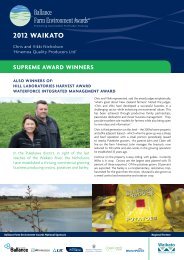Dairy's role in sustaining New Zealand - Fonterra
Dairy's role in sustaining New Zealand - Fonterra
Dairy's role in sustaining New Zealand - Fonterra
Create successful ePaper yourself
Turn your PDF publications into a flip-book with our unique Google optimized e-Paper software.
3. Milk solids price spike<br />
3.1 Headl<strong>in</strong>e results<br />
A short term <strong>in</strong>crease <strong>in</strong> the price of milk solids generates immediate benefits for the national<br />
economy. The national benefit of an <strong>in</strong>crease of $1/kg <strong>in</strong> the <strong>Fonterra</strong> payout is a welfare<br />
ga<strong>in</strong> of $1.2 billion, as proxied by private and public consumption. In addition, national GDP<br />
is expected to rise by $400 million 8 . The richer dairy sector would generate employment of<br />
approximately 4,600 more FTEs and wages would later start to rise 9 .<br />
The welfare ga<strong>in</strong> is larger than the GDP ga<strong>in</strong> due to the impact of exchange rate movements:<br />
• the improved terms of trade allows us to consume more of our GDP (i.e. we have to<br />
export less to pay for a given amount of imports – mak<strong>in</strong>g the country better off as a<br />
whole)<br />
• the currency appreciation leads to a reduction <strong>in</strong> the value of <strong>New</strong> <strong>Zealand</strong>’s foreign debt.<br />
Both effects improve <strong>New</strong> <strong>Zealand</strong>ers’household purchas<strong>in</strong>g power and allow greater<br />
consumption of goods and services.<br />
3.2 Detailed results<br />
3.2.1 Direct effects: the dairy sector<br />
In the first simulation the <strong>in</strong>creased world demand for dairy products drives up both the price<br />
and volume of dairy exports. That is passed on down the supply cha<strong>in</strong> and results <strong>in</strong> a $1<br />
per kilogram of milk solids <strong>in</strong>crease <strong>in</strong> payments to dairy farmers. The <strong>in</strong>creased payout and<br />
volumes cause the dairy sector grows strongly to generate the extra production.<br />
The <strong>in</strong>creased payout causes <strong>in</strong>vestment <strong>in</strong> the farm<strong>in</strong>g <strong>in</strong>dustry to grow by 44%, and<br />
employment by 20%. Investment <strong>in</strong> the process<strong>in</strong>g component of the <strong>in</strong>dustry grows by<br />
14% and employment by 5.5%, relative to what would otherwise have occurred. Investment<br />
growth is higher than employment growth because capital accumulation tends to lag beh<strong>in</strong>d<br />
employment growth. The farm<strong>in</strong>g component of the sector grows more strongly because<br />
we have assumed that the benefits of higher world prices will be passed on to farmers. If<br />
dairy processors were to <strong>in</strong>crease their profit marg<strong>in</strong>s <strong>in</strong>stead then the differences would<br />
dim<strong>in</strong>ish 10 .<br />
8. This is on top of the <strong>in</strong>come generated by the ‘base’price. That is, if the 2011 price (say) is $5 and the 2012 payout is $6, our results<br />
look just at the additional <strong>in</strong>come generated by the $1 price <strong>in</strong>crease.<br />
9. The direct impact on the economy of a $1 <strong>in</strong>crease <strong>in</strong> the milk solids price is a $1.3 billion <strong>in</strong>crease <strong>in</strong> gross output. That gross<br />
output generates about $590 million of GDP once the cost of <strong>in</strong>termediate <strong>in</strong>puts is subtracted. Furthermore, the effect of the<br />
<strong>in</strong>creased dairy output is to <strong>in</strong>crease the price of resources to other <strong>in</strong>dustries and thus reduce their output. The net effect on GDP<br />
of the $1.3 billion <strong>in</strong>jection, once all these effects have been taken <strong>in</strong> to account, is the $400 million we report.<br />
Dairy’s <strong>role</strong> <strong>in</strong> generat<strong>in</strong>g growth<br />
13
















